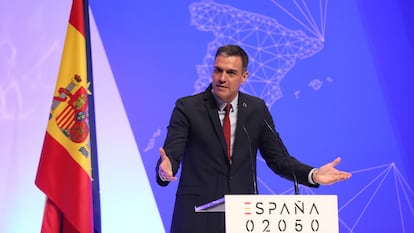Spain’s PM announces sweeping plan to transform country by 2050
The development project, which is now open to discussion, proposes reforms in education, healthcare, taxes, jobs, pensions and the environment over the next three decades

Spain’s prime minister, Pedro Sánchez of the Socialist Party (PSOE), on Thursday presented España 2050, a sweeping development plan for the country aimed at improving performance on key issues such as education, health, pensions, jobs, taxes and the environment over the next three decades.
The 675-page document received input from more than 100 experts from various fields and ideological backgrounds, and it is now open to amendments by political parties, local and regional authorities, unions and employer groups, non-profits and universities.
In the presentation, the Spanish leader called for “a great national dialogue on the future of Spain” to be carried out over the coming months. “Let’s have a dialogue to decide what kind of a country we want to be 30 years from now,” said Sánchez, who heads a minority center-left coalition government with junior partner Unidas Podemos.
The executive said that the plan takes into account the economic and social effects of the coronavirus pandemic. The following are some highlights from the program:
Education

Education remains Spain’s biggest challenge between now and 2050, according to Sánchez. Demographic changes have reduced the number of students between the ages of three and 15, and this will enable the state to increase its spending per student from the current €4,880 to around €9,640 by 2050, similar to what Denmark now spends.
Authorities want Spain to improve its historically poor performance on the PISA student assessment program, run by the Organisation for Economic Cooperation and Development (OECD), by 20 points. This would put Spain at the European average of 500 points.
The program also wants to see a 20% increase in graduates with a degree higher than a secondary school diploma. Spain continues to lead European school-dropout rates at 17%, compared with the EU average of 10%. The goal is to bring this figure down to 3%.
Environment

By 2050, Spain will need to have reduced greenhouse gas emissions, and the other 10% will have to be offset by carbon sinks such as forests. This same goal was already approved by the Cabinet in late 2020 in its Long-Term Decarbonizing Strategy. A recently approved climate change law also seeks a 23% reduction in emissions by 2030.
The plan highlights the need to change consumer habits, such as eating less animal protein and reducing waste from clothing and cellphone purchases. “This reduction in certain types of consumption will not lead to worse living conditions or less wellbeing for citizens,” says the report.
One of the program’s most eye-catching proposals, which goes further than anything the government had suggested to date, involves green taxes. The report holds that it will be necessary “to adapt taxes to the new reality of transportation in order to correct its negative externalities,” alluding to engine emissions. The plan proposes equal taxes for diesel and gasoline vehicles, and raising green taxes to reach the European average by 2030. This would represent 2.6% of Spain’s gross domestic product (GDP), up from the current 1.8%. By 2050, this figure should have reached 5%.
The aviation industry is also targeted. The report recommends “a frequent flyer tax or the introduction of taxes on plane fares depending on the distance to the destination.” Experts would like to ban all flights where the same distance could be covered by train in two-and-a-half hours. So far, the government has refrained from including such a measure in its environmental legislation.
Healthcare

The report recommends raising health spending from 5.7% of GDP to 7% over the next decade. Besides channeling more resources to a strained system, experts also suggest ending medical procedures “whose effectiveness, safety and efficiency has not been proven.” To this end, there would be a new independent agency to oversee an efficient use of resources and to encourage, reduce or even eliminate procedures when the cost is considered to exceed the health benefits.
The report acknowledges that the system requires “deep institutional changes” to improve management, transparency and accountability, and to encourage citizen and professional participation in decision-making.
Spain has a life expectancy of 83 years, just behind Japan and Switzerland, and by 2050 it is expected to be over 86. This will require changes in the healthcare system’s “current organizational model, very oriented towards the treatment of acute events, in favor of a model more focused on chronic issues.”
Social services

Thirty years from now, one in every three people will be 65 and over. The report notes that not even a higher fertility rate – which is expected to rise from 1.2 children per woman to 1.4 – nor immigration will make up for the shortage of working-age individuals. The number of dependent people eligible for aid could nearly double by 2050 to reach 1.6 million.
In light of this forecast, experts want to revamp funding for Spain’s caregiving system, which currently receives only 0.8% of GDP, below most developed countries in Europe. This figure could rise to around 2.5% by 2050. A share of the resources would go toward training for caregivers and to raise awareness about the social relevance of this work. The plan also envisions letting citizens choose between care at home, at an outside facility or a mixed system. Experts would like to see new types of caregiving centers emerge that would more closely mirror the experience of living at home.
Pensions
The report suggests raising the retirement age to reflect higher life expectancy. Three decades from now, for every person over 64 there will be 1.7 people of working age, compared with 3.4 today. This means that government spending on pensions could rise by as much as five percentage points. “The pensions system will have to overcome the triple challenge of assuring its financial sustainability, offering adequate income to retirees, and guaranteeing equal treatment for all generations.”
Some of the ways to reduce the GDP share of pension spending could include “legal changes in the way pensions are calculated, and greater salary growth tied to greater productivity.”
Taxes

The plan sets out a goal to raise tax revenues from 35% of GDP in 2019 to 37% by 2030, 40% by 2040 and 43% by 2050, thereby reducing the seven-point difference between Spain and the eurozone.
To do this, the government could expand taxable income, reduce some tax benefits, and eliminate the módulos system for the self-employed, which taxes their income based on estimates.
Experts also recommend “a comprehensive reform” of income, wealth, inheritance and gift taxes. As for the last two levies, the report notes that different regions of Spain currently have widely varying rates, and that these should be “harmonized to avoid undesirable strategies of unfair competition.”
The plan also envisions higher taxes on alcoholic beverages, tobacco products and petroleum-derived fuels, as well as incentives to encourage a greener economy. There is a special focus on vehicles, which should be taxed based on their real use and characteristics, including their weight, power and emissions.
The report also addresses the need for corporate tax reform, which includes action at the international level. Spain is urged to push the EU for harmonized categories of taxable income, a minimum tax rate and a solution for taxing technology companies.
The underground economy is also targeted through greater coordination among tax agencies, greater information exchange, a ban on tax amnesties and promoting education in schools.
Public sector
The plan sets out a series of measures to improve efficiency, such as creating a culture of evaluation and accountability at all public agencies and departments. There should be efforts to digitalize the public sector to ensure that citizens can conduct most of their services online. In the long term, artificial intelligence could be used to analyze information, design policies and evaluate services. Examples of useful applications include real-time data on the evolution of the job market, the cost of medical procedures and statistics on social services.
Civil servant examinations should be revamped and constant training conducted to ensure that government employees have the skills required for the job at all times. The report also recommends a system of evaluation and incentives to promote and retain talent.
Employment
The report proposes reducing the working week to 35 hours, as well as increasing the presence of currently under-represented groups in the workplace.
An ageing population will mean a smaller workforce, and in order to offset this drop, Spain should take steps to increase the amount of women, youths and people over 55 in the job market. Efforts should also be made towards the integration of immigrants in the labor market. The goal is to increase the employment rate by 15 percentage points over the next 30 years.
Living
Experts suggest making the most of existing trends such as digitalization to curb the exodus of people moving from the countryside to the cities. Reversing this trend would “make cities healthier, more cohesive and sustainable, and it would improve living conditions and opportunities in small-to-medium municipalities.”
The document explains that in order to achieve balanced territorial development, the role of middle-sized cities must be reinforced, while smaller locations should have improved access to services and technology.
With reporting by Laura Delle Femine, Jesús Sérvulo González, Oriol Güell, Antonio Maqueda, Manuel Planelles, María Sosa and Ana Torres.
English version by Susana Urra.
Tu suscripción se está usando en otro dispositivo
¿Quieres añadir otro usuario a tu suscripción?
Si continúas leyendo en este dispositivo, no se podrá leer en el otro.
FlechaTu suscripción se está usando en otro dispositivo y solo puedes acceder a EL PAÍS desde un dispositivo a la vez.
Si quieres compartir tu cuenta, cambia tu suscripción a la modalidad Premium, así podrás añadir otro usuario. Cada uno accederá con su propia cuenta de email, lo que os permitirá personalizar vuestra experiencia en EL PAÍS.
¿Tienes una suscripción de empresa? Accede aquí para contratar más cuentas.
En el caso de no saber quién está usando tu cuenta, te recomendamos cambiar tu contraseña aquí.
Si decides continuar compartiendo tu cuenta, este mensaje se mostrará en tu dispositivo y en el de la otra persona que está usando tu cuenta de forma indefinida, afectando a tu experiencia de lectura. Puedes consultar aquí los términos y condiciones de la suscripción digital.
More information
Últimas noticias
There is as much life left to discover on planet Earth as that which is already known
Dozens presumed dead, around 100 injured in fire at Swiss Alps bar during New Year’s celebration
Is porn for women different from conventional porn? We spoke to those who make it
Cartagena de Indias is sinking: What can the city do to mitigate it?
Most viewed
- Reinhard Genzel, Nobel laureate in physics: ‘One-minute videos will never give you the truth’
- Sinaloa Cartel war is taking its toll on Los Chapitos
- David King, chemist: ‘There are scientists studying how to cool the planet; nobody should stop these experiments from happening’
- Oona Chaplin: ‘I told James Cameron that I was living in a treehouse and starting a permaculture project with a friend’
- The Interoceanic Train, the Mexican alternative to the Panama Canal










































